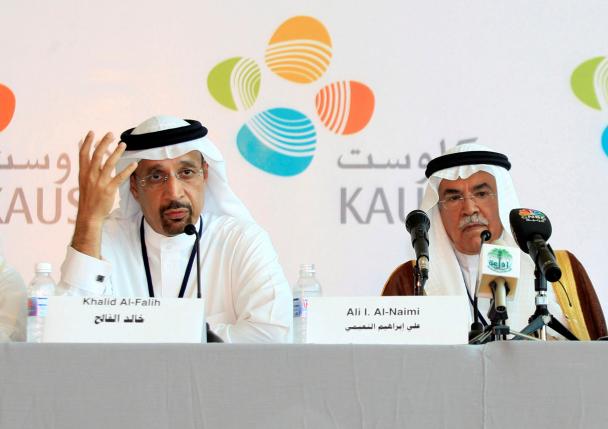
Managing Saudi Arabia’s new energy mega-ministry, set to oversee over half the economy and designed to cut through a tangled bureaucracy to make government more coherent and efficient, will be a formidable challenge.
The new Energy, Industry and Mineral Resources Ministry, under Khalid al-Falih, already chairman of state oil company Saudi Aramco, will handle oil and gas extraction, power generation and distribution, mining and industrial development.
The changes were announced on Saturday as part of a major reshuffle by King Salman aimed at making the Vision 2030 economic reform program easier to implement by ending decades of miscommunication and turf war between government departments.
But in creating a ministry to oversee sectors that account for 53 percent of the kingdom’s economic output, the vision’s architect, Deputy Crown Prince Mohammed bin Salman, is entrusting a huge part of his sweeping reforms to Falih’s hands.
How the new minister will juggle a host of responsibilities, and whether he can enact massive change across this broad swathe of the economy while integrating once rival departments, is already fodder for avid speculation in Saudi energy circles.
“In order for the restructuring to succeed, accountability and responsibility has to be concentrated in the same office. This is the reason for assigning all those sectors in one ministry,” said Sadad al-Husseini, an energy consultant and former senior executive with Saudi Aramco.
“It remains to be seen what kind of specific organizational changes happen at the operational level.”
Previously, the oil ministry was in charge of hydrocarbons extraction and mining, the water and electricity ministry handled power generation and the commerce ministry oversaw industry. Other departments overlapped with these, covering such policy areas as nuclear and renewable energy and the running of industrial cities.
The big state-controlled companies, oil producer Aramco, petrochemicals and metals conglomerate Saudi Basic Industries Corp (Sabic), Saudi Arabian Mining Co (Maaden) and state utility Saudi Electricity Co (SEC), fit in between them. Falih is likely to now have a big say in running them all.
STREAMLINING
Saudi Arabia’s creation of the new energy ministry sets it on the same path as oil-producing Gulf neighbors Qatar and the United Arab Emirates, which have done the same.
“What was required before was coordination and a clear common vision, a clear strategy,” said Paddy Padmanathan, president and chief executive officer of Acwa Power, the kingdom’s biggest private electricity developer.
Riyadh’s hopes of cutting state spending and diversifying the economy beyond oil have always rested partly on the goal of using energy resources to expand industrial output in ways that would add value, create jobs and boost non-oil exports.
However, its dominant petrochemicals industry, under the commerce ministry, and power utilities, under the water and electricity ministry, sometimes clashed over allocations of gas, which was produced by Aramco, under the oil ministry.
Meanwhile, cheap energy prices encouraged power producers to employ cheaper, less efficient technology that used much larger quantities of fuel than they would have chosen were it valued at market prices, Padmanathan said.
Rampant overuse of fuel, blamed by economists on the large subsidies, has also bloated Saudi domestic energy consumption, raising fears that it would eventually cut into the amount of oil free for export.
Saudi rulers have known about these problems for years, but past reform efforts appeared to be hindered by inter-departmental fighting.
The agency responsible for atomic and renewable energy, for example, proposed that a big part of Saudi power production should come from solar and nuclear plants, but its plans were quietly shelved after other parts of the bureaucracy objected.
Now Falih has been made chairman of that agency, giving him power as energy minister to see proposals through, and the government has pledged to install at least 9.5 gigawatts of solar power.
ARAMCO CHALLENGE
The one Saudi body that has traditionally crossed all these sector lines is Aramco, of which Falih was chief executive from 2009-15, and of which he remains chairman in his new role as energy minister.
Beside its core oil and gas upstream business, Aramco has big downstream refining and petrochemical factories through joint ventures with international partners, it has an in-house power unit and has carried out solar projects.
However, Aramco itself is approaching a major change as the government readies it for an initial public offering of up to 5 percent of its value on the stock market. That will require unprecedented internal adjustments including publication for the first time of sensitive reserves and balance sheet data.
Overseeing that process will be an immensely challenging job not only for the company’s chief executive, Amin Nasser, but for its chairman Falih as well.
At the same time, he will now be in charge of expanding the mining sector to create a targeted 90,000 new jobs by 2020, ensuring power supply meets an expected tripling of consumption by 2030 and a doubling of gas output by the same date.
Falih is said to be close to Prince Mohammed, but the deputy crown prince has shown over the past year that he has no compunction about sacking favorites if they fail to meet expectations.
“I expect this to be the first round of changes. Definitely there will be more rounds until you find the right mix of people for the vision 2030,” said a senior banker who declined to be identified.
Reuters
Leave a Reply
You must be logged in to post a comment.